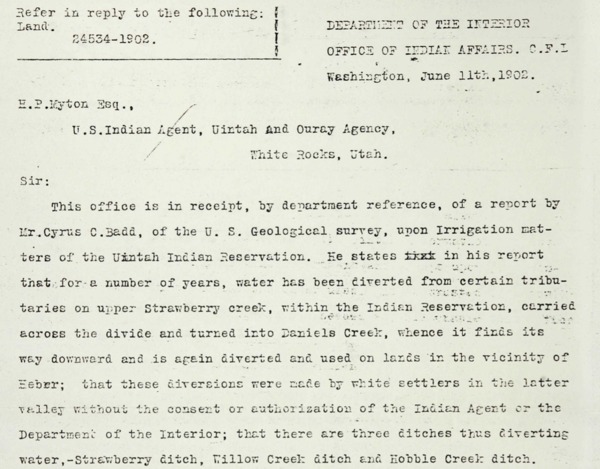Dublin Core
Title
Description
Water in Utah is a precious resource, and many have stretched the law to control it. In 1879, a group of farmers at the mouth of Daniels Canyon diverted water that belonged to the Uintah Valley Ute Reservation to irrigate crops in Heber Valley. Although this trespass was illegal, white settler ideas about land use allowed the theft to continue.
During the last decades of the 1800s, white farmers dug miles of canals, built reservoirs, and even dug an eight-hundred-foot tunnel through the mountain. This system, built and maintained by two different canal companies with dozens of investors, pulled water from the Strawberry River in one watershed—across the Reservation boundary—into another.
The Strawberry Canal system had support from the Reservation’s Indian Agent, who petitioned the Utah government in 1902 on its behalf, even as he acknowledged that the farmers had “no legal right to this water.” In 1905, the federal government sent an Army unit to destroy the diversion but the Secretary of the Interior intervened, arguing that the farmers had been accessing the resource “for many years, and that the diversion of the water … [had] not been in any manner detrimental to the Indians.”
So, no one denied that the diversion was illegal, but the dispute rested on cultural ideas about how water should be used. Fundamental to Western water law is the principle of “use it or lose it” and for white settlers, water was meant for irrigation. But Utes had their own values and uses for water, and were not channeling it into irrigation ditches for individual plots, despite government pressure to do so. Because Utes were not using their water in the same way as white farmers, government officials decided that their water was not being used.
The Daniels Diversion remained until 1992 and set the stage for larger scale diversions of water from the Uinta Basin to the Wasatch Front. The legacy of this contentious theft is still felt in legal battles over water between the Ute Tribe and the state government that remain unresolved.
Creator
Source
______________
See Kathryn L. MacKay, “The Strawberry Valley Reclamation Project and the Opening of the Uintah Indian Reservation,” in John S. McCormick and John R. Sillito, ed., A World We Thought We Knew: Readings in Utah History (Salt Lake City: University of Utah Press, 1995); Craig W. Fuller, Robert E. Parson, and F. Ross Peterson, Water Agriculture and Urban Growth: A History of the Central Utah Project (Salt Lake City: Utah State Historical Society, 2016); National Park Service and Bureau of Reclamation, Beyond the Wasatch: The History of Irrigation in the Uinta Basin and Upper Provo River Area of Utah by Gregory D. Kendrick and Charles S. Peterson, Paper 551 (Utah State University Regional Depository: All U.S. Government Documents, 1991); Craig Fuller and Craig Woods, "Development of Irrigation in Wasatch County" (Utah State University: All Graduate Theses and Dissertations, 1973); Office of Indian Affairs, "Letter to Agent H.P. Myton dated June 11, 1902," J. Willard Marriott Library, accessed May 2021; “A Century of Stewardship: Strawberry Valley Management Area," USDA Forest Service, accessed May 2021.

